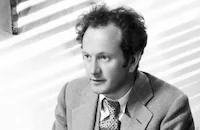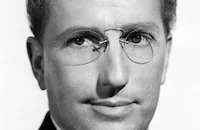A Kiss for Corliss

Brief Synopsis
Cast & Crew
Richard Wallace
Shirley Temple
David Niven
Tom Tully
Virginia Welles
Darryl Hickman
Film Details
Technical Specs

Synopsis
Wealthy playboy Kenneth Marquis is divorcing his third wife, and seventeen-year-old Corliss Archer, whose father Harry is the attorney for Mrs. Marquis, follows the trial avidly. After the matter has been decided, Marquis and his lawyer, Taylor, come to Harry's office to discuss Mrs. Marquis' huge settlement, and as soon as Corliss meets Marquis, she is smitten by the suave older man. Marquis plays up to Corliss, enjoying her father's irritation. The next day, Harry tells Corliss that he saw her boyfriend, Dexter Franklin, with another girl at the Penguin Club, a local restaurant notorious for its back-room gambling. That night, while Corliss and her friend, Mildred Pringle, are having a slumber party, Mildred's enterprising younger brother Raymond comes over and offers to bind Corliss' diary in leather for a fee. Corliss instructs Raymond to come back tomorrow, then tells Mildred that she will get even with Dexter by writing mean things about him in her diary, which she is certain Raymond will show to him. When an elaborate box of candy arrives from Marquis, Corliss decides to make Dexter jealous, and she and Mildred fill the diary with glowing descriptions of her supposed romance with Marquis. The next day, a repentant Dexter tries to make up with Corliss, and she persuades him to take her to the Penguin Club that evening. Dexter and Corliss sneak into the club just as a police raid begins, and hide in the basement until the police are gone, only to discover that they are locked in. The Archers panic when they learn their daughter is missing, and after Dexter and Corliss finally escape through a window and return to her home, they see a police car in front of the house. Corliss swears Dexter to secrecy about their adventure and decides to fake amnesia, pretending to remember nothing that happened since she was nine years old. In the morning, Raymond delivers Corliss' diary, and her parents decide to read passages to Corliss in an attempt to stimulate her memory. Harry is beside himself when he reads the fictitious entry stating that Corliss and Marquis are engaged. Meanwhile, the entrepreneurial Raymond shows up at Marquis' office with photostats of the diary and requests that Marquis advertise in the little newspaper he is publishing. Amused, Marquis writes the boy a check, then visits the Archers and tells them that every word of Corliss' overblown prose is true. Corliss explains what happened at the Penguin Club and confesses that she faked amnesia, but Marquis, relishing the opportunity to torment Harry, persists in claiming that Corliss was with him the previous night. Neither Dexter nor Mildred will confirm Corliss' story, and when Marquis announces the "engagement" in the newspaper, Harry takes no action, fearing that his daughter's reputation will be damaged if a retraction is printed too soon. The press surrounds the Archers' home, and Raymond shares the diary excerpts with a magazine reporter, who publishes them on the front page. When her parents press her to be honest with them, Corliss feels defeated and tells them that the diary was true, and the Archers resign themselves to the marriage. They ask Corliss' uncle George, a Navy chaplain, to perform the ceremony, and when Harry gives his consent, it is Marquis's turn to be shocked. Following a glum wedding rehearsal at the Archer home, Dexter comes by and asks Harry for legal advice, explaining that he is being blackmailed by a schoolmate about the night he stayed out with Corliss. Raymond then shows up and reports that Marquis bribed Mildred to keep quiet about the diary. Harry and Dexter throw Marquis out, and Dexter and Corliss happily make up.

Director

Richard Wallace
Cast

Shirley Temple

David Niven

Tom Tully

Virginia Welles

Darryl Hickman

Gloria Holden
Robert Ellis
Kathryn Card

Richard Gaines

Roy Roberts
Crew
Robert Aldrich
Annabell
Frank Baur
Jack Baur
Edward Boyle
Robert De Grasse
Howard Dimsdale
Frank Doyle
Karl Herlinger Jr.
Werner R. Heymann
Eloise Jenssen
Gana Jones
Anthony Jowitt
Marcus Loew Ii
Colin Miller
James Nasser
Rudolph Polk
Lewis J. Rachmil
Paul Sawtell
Rudolph Sternad
Frank Webster

Videos
Movie Clip


Film Details
Technical Specs

Articles
A Kiss for Corliss
Temple turned 17 in 1945 and was half a decade past her career zenith as the dimpled child star of such 20th Century Fox hits as The Little Colonel (1935), Heidi (1937), and Rebecca of Sunnybrook Farm (1938). Though she had matured beyond the designation of "America's Sweetheart," Temple remained sufficiently pink of cheek to remain persuasive as the slightly younger Corliss, who threatens to bring shame down upon the Archer family by being too familiar with GIs at the local USO bazaar. The film was a success for Columbia and excited interest in a follow-up. By 1949, however, Temple was 21 years old, a young mother, and on the cusp of a highly-publicized divorce from actor-husband John Agar. With Columbia unwilling to move forward with a sequel, independent producer Colin Miller stepped into the breach, snapping up the rights with an assist from the Bank of America and securing a distribution deal with United Artists.
Miller might have thought he had scored a casting coup by securing the participation of actor David Niven, who had enjoyed recent success as one of the stars of The Bishop's Wife (1947). As fate would have it, the long-time Samuel Goldwyn contract player was at the end of his tether as a for-hire actor, feeling that Goldwyn had squandered his potential by loaning him out to other studios. (Of the 34 films Niven made while under contract to Goldwyn, only 9 were for his home studio.) Resentful at being cashiered into service in a string of unworthy film projects, Niven was also mourning the loss of his wife, Primula Rollo, who had died two years earlier in a freak fall at Tyrone Power's house at the age of 28. Consigned to a cameo as a divorced playboy who becomes the fantasy inamorato of Corliss Archer, Niven was vocal in his disdain for the assignment, affecting (in his own words) "spoiled brat behavior of the worst sort... idiotic, conceited, indefensible and unforgiveable."
Niven's cavalier attitude toward his role in A Kiss for Corliss did not sit well with his costar, long known in Hollywood as a stickler for absolute fidelity to the script. As Niven continually went up on his lines, Shirley Temple rolled her eyes at the cast and crew assembled under the roof of General Service Studios. During production the actress suffered not one but two appendicitis scares that were ultimately put down to stress-induced stomach aches, while also suffering from infected wisdom teeth. Problems with the talent were not the only cause of headaches on the set of A Kiss for Corliss. Officers of the Production Code of America objected to Niven's character having weathered six divorces and advised that Howard Dimsdale's script be altered to cut that number in half so as not to trivialize the tragedy of divorce. The PCA also made sure that Corliss articulate in no uncertain terms that she "could never think of marrying a man with all those wives."
A Kiss for Corliss's failure at the box office (even when retitled Almost a Bride) prompted Niven to break his contract with Samuel Goldwyn. The steely, mercurial Goldwyn calmly consented to Niven's request... and then instructed his publicity department to announce that the ungrateful actor had been fired. As for Shirley Temple, she never made another film. Taking a much needed vacation from work and the ugly divorce proceedings that would leave her a single mother at age 21, Temple flew to Hawaii, where she fell in love with an employee of the Hawaiian Pineapple Company named Charles Black. Though she made a few tentative steps towards furthering her career (including an abortive bid to replace Jean Arthur in the 1950 Broadway revival of Peter Pan), she became Shirley Temple Black in December 1950. She returned to television briefly toward the end of the decade but her life path diverted to politics. A lifelong Republican, Temple served as the United States Ambassador to both Ghana and Czechoslovakia before her death in February 2014 at the age of 85.
By Richard Harland Smith
Sources:
Shirley Temple: American Princess by Anne Edwards (William Morrow & Co., 1988)
Child Star, An Autobiography by Shirley Temple Black (McGraw-Hill Publishers, 1988)
The Shirley Temple Story by Lester David and Irene David (GP Putnam &Sons, 1983)
The Shirley Temple Scrapbook by Loraine Burdick (Jonathan David Publishers, Inc., 2003)
Shirley Temple by Jeanine Basinger: Pyramid Illustrated History of the Movies (Pyramid Publishers, 1975)
The Last Gentleman: A Tribute to David Niven by Peter Haining (WH Allen, 1984)
David Niven: A Bio-Bibliography by Karin J. Fowler (Greenwood Press, 1995)
The Films of David Niven by Gerard Garrett (The Citadel Press, 1976)
Niv: The Authorized Biography of David Niven by Graham Lord (Thomas Dunne Books, 2003)
The Moon's a Balloon: An Autobiography by David Niven (GP Putnam & Sons, 1972)

A Kiss for Corliss
Quotes
Trivia
Notes
A Hollywood Reporter news item stated that producer Colin Miller was borrowing Leon Ames from M-G-M for the picture, but Ames was not in the released film. According to information in the file on the film in the MPAA/PCA Collection at the AMPAS Library, the Breen Office disapproved of the film's "extremely light attitude toward marriage." A compromise was eventually reached when the number of "Kenneth Marquis'" failed marriages was reduced from six to three.
A Kiss for Corliss was a sequel to the 1945 film Kiss and Tell. According to a October 17, 1949 Hollywood Reporter news item, independent financeer Henry G. Kuh entered into negotiations with Miller to produce a third "Corliss Archer" picture, Corliss Goes Abroad, which would also star Shirley Temple. However, the twenty-one-year-old Temple retired from films after the release of A Kiss for Corliss. This was the last film that David Niven made under his contract with Samuel Goldwyn, from whom Miller borrowed Niven for the production. For more information on the character of Corliss Archer, please see the entry above for Kiss and Tell. Some modern sources state that this film was later retitled Almost a Bride.














